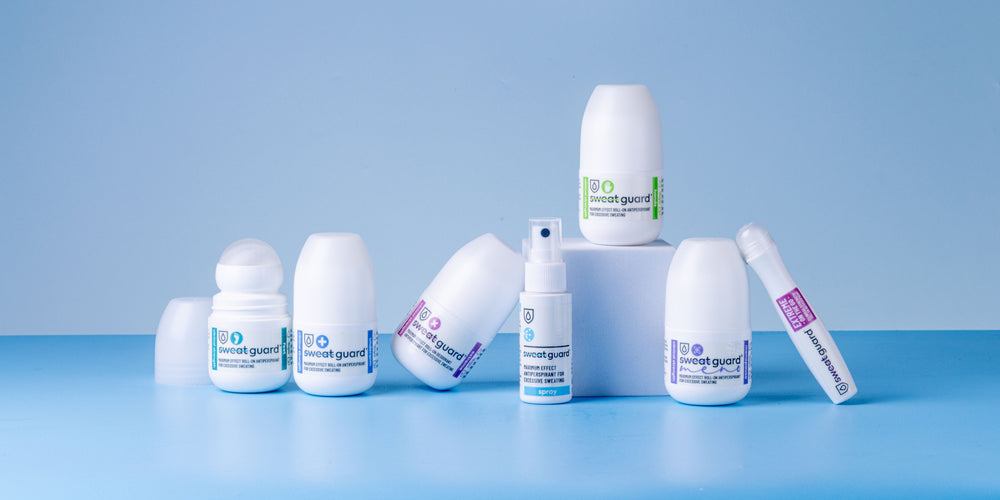Excessive Teen Sweating: A Parent's Guide
Definition and Prevalence
Excessive sweating, medically known as hyperhidrosis, is a condition that can significantly impact teenagers. It involves abnormal, excessive sweating that isn't related to heat or exercise. While sweating is a natural bodily function, hyperhidrosis in teenagers goes beyond the usual physical response to temperature or physical activity. It's estimated that about 1-3% of the population suffers from this condition, showing its prevalence among teens.
Physical and Psychological Impacts
The physical effects of teen excessive sweating extend beyond the discomfort of damp clothes and a lingering need for teen hygiene and sweating management. It can also lead to skin irritations and infections because of the constant wetness. However, the psychological toll is often heavier. Teens, already navigating the complexities of adolescence, may find excessive sweating exacerbating feelings of self-consciousness and embarrassment. This can impact their social interactions, self-esteem, and overall quality of life.
Stress and Anxiety as Triggers
The relationship between mental health and hyperhidrosis is significant, especially in teenagers. Stress and anxiety can act as triggers for excessive sweating. During periods of high stress, such as exams or social events, teens might experience increased sweating. This condition can heighten their stress levels, creating a challenging cycle of teen sweating and anxiety.
Psychological Effects of Hyperhidrosis
The psychological impact of hyperhidrosis in teenagers can be profound. Constant worry about sweat stains and body odour can lead to heightened self-consciousness and anxiety. This can affect a teen's social life, academic performance, and participation in activities. The fear of being noticed or judged for their sweating can also lead to social withdrawal, adding to feelings of isolation and loneliness.
The Stigma Around Sweating
There is a considerable stigma attached to excessive sweating, especially among teens. Misunderstandings about hygiene and misconceptions about the causes of teen sweating often lead to unfounded judgments. This stigma can make teenagers feel embarrassed and reluctant to seek help or talk about their condition.
Importance of Public Awareness
Raising public awareness about hyperhidrosis is vital. It helps in demystifying the condition, making it easier for teens and their parents to understand and manage teen hyperhidrosis, effectively. Awareness also fosters empathy and support within communities, schools, and families, creating a more understanding environment for those affected.
Peer Pressure and Bullying
Teenagers with hyperhidrosis often face challenging social dynamics. Peer pressure and bullying related to teen excessive sweating can be a harsh reality. Comments or teasing about sweat marks or odour can significantly impact a teen's self-esteem and confidence, making school and social events daunting experiences.
Social Isolation and Withdrawal
Because of fear of embarrassment or being bullied, teenagers suffering from excessive sweating might choose to withdraw from social interactions. This isolation can affect their ability to form friendships and take part in group activities, further impacting their social skills and emotional development. The anxiety associated with sweating and the potential social repercussions can lead to a cycle of avoidance and increased feelings of loneliness.
Physical Symptoms
Identifying excessive sweating in teens can be straightforward when observing certain physical symptoms. These include sweat-soaked clothing, especially under the arms or on the back, even in cool temperatures or without physical exertion. Frequent complaints about feeling overheated or needing to change clothes because of sweating are also common indicators. Signs like palm wetness or visibly sweaty feet can point to hyperhidrosis.
Behavioural Indicators
Apart from physical symptoms, behavioural changes can also signal excessive sweating issues. This might include reluctance to take part in physical activities, avoidance of social situations, or a sudden drop in academic performance. Teens might also become overly self-conscious about their body odour or start carrying excessive hygiene products, showing a concern about their sweating.
Communication Strategies
Open and empathetic communication is key when addressing teen excessive sweating with your child. It's important for parents to approach the topic sensitively, ensuring the teen feels heard and understood. Ask open-ended questions to understand their experiences and concerns. Avoid making assumptions or dismissing their feelings, as this can lead to further withdrawal. Encouraging an open dialogue helps in identifying the best ways to support them.
Creating a Supportive Environment
Creating a supportive environment involves both emotional and practical support. Emotionally, parents should reassure their teen, emphasising that hyperhidrosis is a common issue and not something to be ashamed of. Practically this includes exploring treatment solutions which typically start with clinical strength antiperspirants, and which can be complemented by various additional treatment options.
Treatment Options
There are various treatment options for managing hyperhidrosis in teenagers. At Sweat Guard® we offer many solutions that don’t require a trip to the GP. There includes the use of clinical strength antiperspirants, which contain the active ingredient aluminium zirconium tetrachlorhydrex gly to reduce sweating. Iontophoresis, a procedure that uses electrical currents to block sweat glands, can be effective, especially for hand and feet sweating. Sweat Guard®’s Iontophoresis machines are clinically proven, CE marked - UK/EU approved safe to use at home and are highly recommended before considering Botox injections, or even surgery. Use of Sweat Guard®’s clinical strength antiperspirants and iontophoresis machines can be highly effective treatment options for most sufferers, but for the more severe cases it's essential to discuss these options with a healthcare professional. They can help determine the most suitable course of action based on the severity and impact of your teen's symptoms.
Conclusion: Empowering Teens and Their Families
In conclusion, understanding and managing hyperhidrosis in teenagers is a journey that involves awareness, support, and appropriate sympathetic intervention. Recognising the signs, both physical and behavioural, is the first step towards helping your teen navigate through this challenge. It's essential for parents to provide a nurturing environment marked by open communication and empathy. By breaking the stigma and fostering awareness, we can create a supportive community for teenagers dealing with excessive sweating.
Encourage your child to manage their condition, whether it's through lifestyle adjustments, or psychological support. Remember, with the right approach, teen excessive sweating can be effectively managed, allowing your teen to lead a confident and fulfilling life.
FAQs on Teen Sweating and Mental Health
Q: Is excessive sweating in teens a sign of an underlying health issue?
A: While it can be, most cases of teen excessive sweating are primary hyperhidrosis, which isn't typically caused by other health issues. However, it's always a good idea to consult a healthcare provider for a proper diagnosis.
Q: Can lifestyle changes help manage teen sweating?
A: Yes, certain lifestyle adjustments like sweat-proofing clothing with Sweat Guard®’s triple absorbent sweat pads for teenagers and adults, maintaining good hygiene, and using appropriate antiperspirants can help manage the symptoms.
Q: How does excessive sweating affect a teen's mental health?
A: It can lead to increased self-consciousness, anxiety, and social withdrawal, impacting their overall well-being and quality of life.




